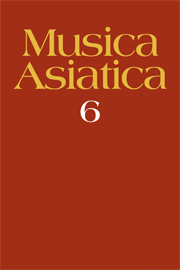Book contents
- Frontmatter
- Contents
- Preface
- Koguryo instruments in Tomb No. 1 at Ch'ang-ch'uan, Manchuria
- Shakuhachi honkyoku notation: written sources in an oral tradition
- The world of a single sound: basic structure of the music of the Japanese flute shakuhachi
- A report on Chinese research into the Dunhuang music manuscripts
- Where did Toragaku come from?
- Musico-religious implications of some Buddhist views of sound and music in the Śūraṅgama Sūtra
- Composition and improvisation in Satsuma biwa
- Glossary of Chinese, Japanese and Korean terms
- Contributors to this volume
- Notes for authors
- Frontmatter
- Contents
- Preface
- Koguryo instruments in Tomb No. 1 at Ch'ang-ch'uan, Manchuria
- Shakuhachi honkyoku notation: written sources in an oral tradition
- The world of a single sound: basic structure of the music of the Japanese flute shakuhachi
- A report on Chinese research into the Dunhuang music manuscripts
- Where did Toragaku come from?
- Musico-religious implications of some Buddhist views of sound and music in the Śūraṅgama Sūtra
- Composition and improvisation in Satsuma biwa
- Glossary of Chinese, Japanese and Korean terms
- Contributors to this volume
- Notes for authors
Summary
In an editorial note to the previous volume of Musica Asiatica, Richard Widdess foreshadowed that future volumes of Musica Asiatica would explore specific themes. This is the first such volume, dedicated to the music of East Asia. Just as its contents were being finalised, we heard of the death of a member of our Editorial Board, Yōko Mitani. This volume is dedicated to her memory. It will stand, I trust, as a lasting monument to her scholarship and to the generosity and support she showed to all of us who were privileged to call her a friend and colleague.
Laurence Picken, founding editor of this journal, has written the following tribute to Dr Mitani:
The death of Professor Yōko Mitani at the age of 53, after a painful wasting illness of three years' duration, has deprived the members of the Tang Music Project of a greatly valued, scholarly colleague, and a dear friend. It was in the mid-seventies, during her tenure of a position as Visiting Scholar at Clare Hall, University of Cambridge, that Yōko-san was drawn into our group – largely of graduate-status– and, as koto-player and singer, shared with us the excitement of bringing to life in sound, playing from copies of Japanese manuscripts of the 11th to 13th centuries, music not heard for more than a thousand years. How great was the difference between what she helped to vivify and what has become the practice of those who perform tōgaku in Japan, she was perhaps more fully aware than any of us. […]
- Type
- Chapter
- Information
- Musica Asiatica , pp. ix - xPublisher: Cambridge University PressPrint publication year: 1991

